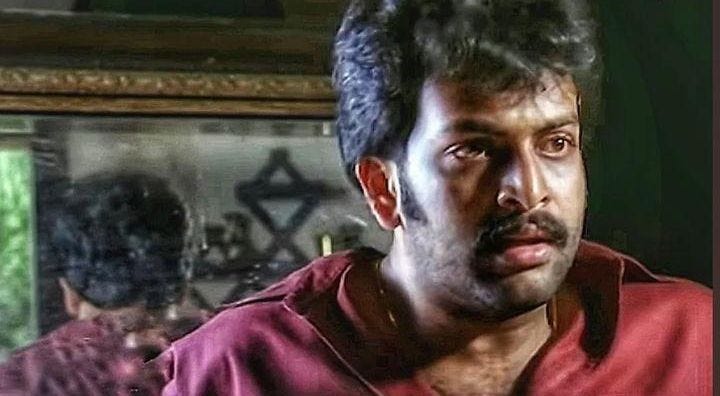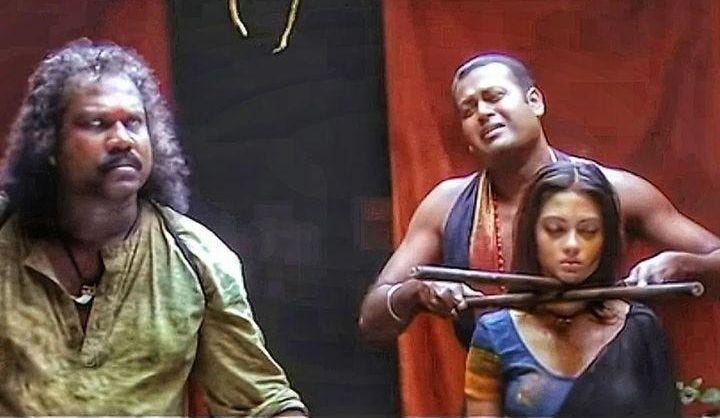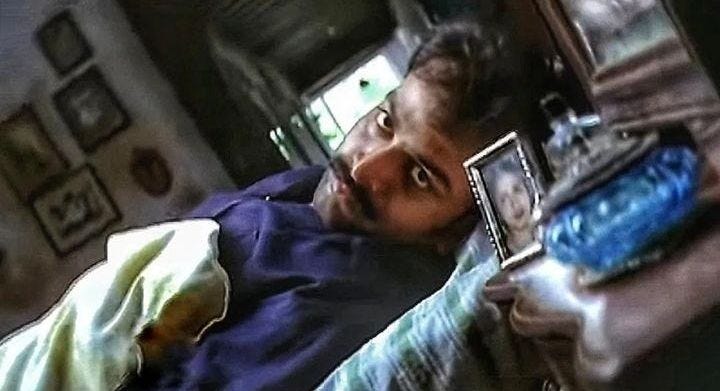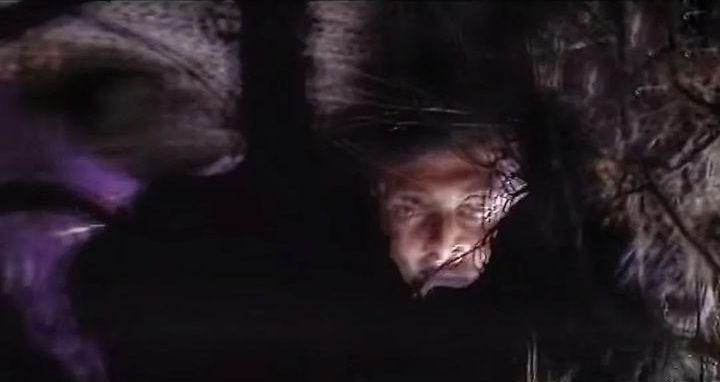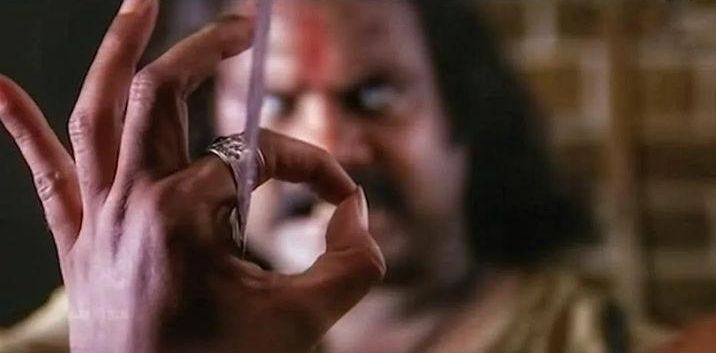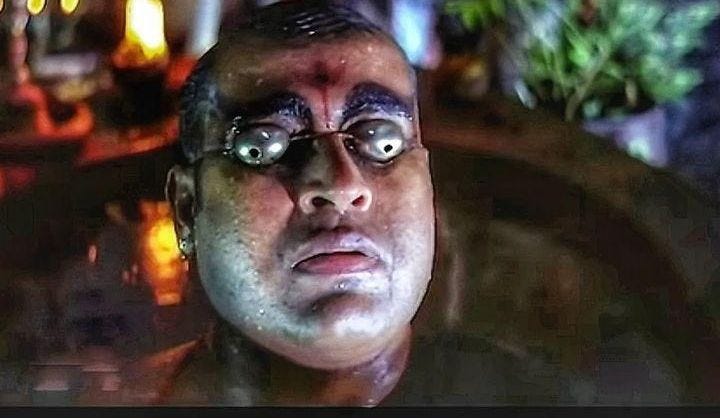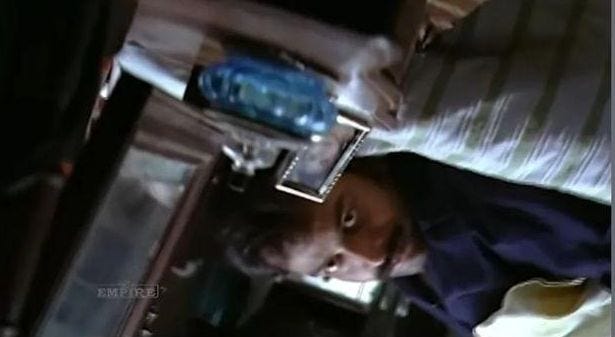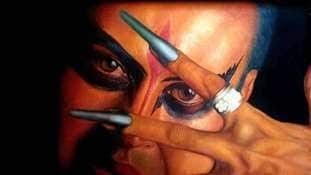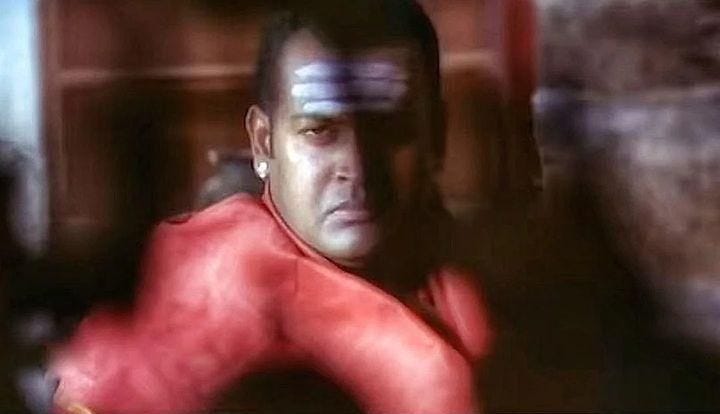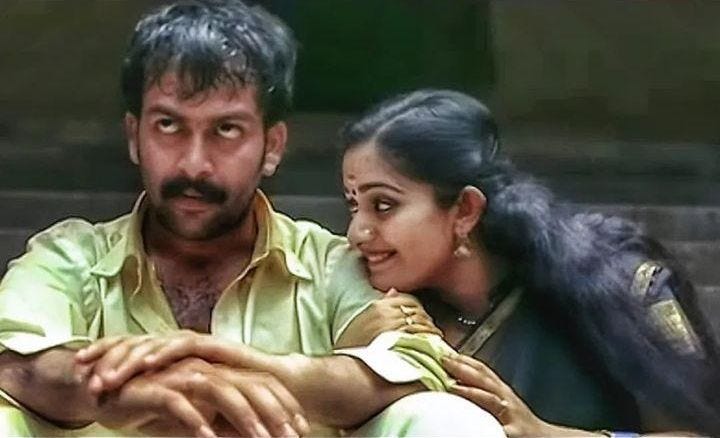Ananthan, a naïve NRI returns to his native village Sivapuram to carry out a ritual for his late mother as per her last wish. Upon his arrival, he is welcomed with open arms by most of the villagers, but also garners the wrath of the village bully- A vile sorcerer named Digambaran who has an ancient rivalry with Ananthan’s family. With his Freddy Kruger-esque metal claws, Digambaran wields the ability to attack his victims in their dreams/visions/trances, treats swordplay like foreplay and uses black magic to transform women into helpless, submissive slaves. Despite the fearsome atmosphere created among the villagers as a result of his cruel and demonic acts, with even the village elders not daring to so much as cross the thresholds of Digambaran’s home let alone his cavernous lair since he’d once blinded one of the villagers with ‘poisonous rains’, Ananthan still boldly takes a stand against the tyrant. But will the young saviour win against pure evil, or much like the others, be forced to submit to Digambaran too?
‘Anandabhadram’ (also known by its Telugu title ‘Sivapuram’) features aspects that are rooted in reality despite the fable-esque tone, bringing to mind the fictitious tales of one’s childhood yet simultaneously excels in exploring themes such as the chokehold of superstitious beliefs and a defiance against tradition. The latter is particularly depicted via the attitudes of the local priests who utilize spirituality as well as the ancient practice of Ayurveda to heal, as compared to the goonish villain’s use of black magic to wage a war against his naysayers as well as his altogether unwelcoming attitude towards new blood such as the US-based Ananthan.
The movie also impresses with its juxtaposition of femininity and divinity, with the costumes and staging of one of its musical numbers ‘Pinakkamaano Ennodinakkamano’ (picturized on Kavya Madhavan’s character Bhadra, a young woman with a vast knowledge of Ayurveda who stands in as the ‘good witch’ with a pure heart, as well as Ananthan’s love interest) resembling the graceful portraits of Indian goddesses painted by artist Raja Ravi Varma. The final act also signifies an end to Digambaran’s tyranny, as Bhama (a name derived from the Sanskrit word for ‘wrath’/’passion’, and is also a name associated with the Hindu practice of Shaktism, i.e. the worship of female deities/goddesses), a young woman who has been fetishized and non-consensually been treated as an object of desire by Digambaran fights back against his vile mind games and reclaims power and agency from her abuser, ultimately taking on a form that is divine yet human , hence serving as a female vanquisher or destroyer of evils. After being forced to put up with his rules for so long, it is only reasonable that Bhama strips him of all dignity and breach his consent. Even the name of its male protagonist Ananthan is one whose origins are steeped into Hinduism, South Indian culture as well as spirituality, as it is yet another name of the Lord Murugan, the son of warrior goddess Korravai and the god of victory/war, so it is but inevitable that Ananthan would lead the oppressed villagers of his native to certain victory against dark forces.
Apart from the keen attention to detail with regards to the character traits and names, another aspect that stands out is the subtle subversion of tropes and archetypes, particularly the ‘Nagin’ movies of yore which have become a subgenre in itself. Instead of the usual route of reducing the creatures to cliched antagonists, ‘Anandabhadram’ opts to humanise the cobras, depicting them as victims of greed and of the controlling tendencies of the human villain, while also being encroached upon in their own territory.
A good horror movie is also constructed through cinematography, and the renowned Santosh Sivan who doubles as cinematographer and director doesn’t disappoint with his eye for detailed aesthetics. His creative genius is on display as he captures both the beauty of the gushing waterfalls and in conveying spinetingling sensations and the turmoil faced by the characters via cinematography alone (one can instantly tell why he and veteran filmmaker Mani Ratnam work so well together). Sivan utilizes his signature mirror shot as a storytelling tool when Ananthan reflects upon his younger self reminding him to fulfill his promise to his late mother. Later, an array of shots ranging from a Dutch angle, dizzying shots to heighten sense of eeriness during Ananthan’s possession sequence as well as a shot of Digambaran’s feet dangling mid-air in the first act and hauntingly levitating over a clueless Ananthan is yet another spooky frame that teases the diabolic events that will unfold as the movie progresses.
The Gothic motifs further enhance this foreboding world-building as a lightning bolt streaks across the night sky to signal Ananthan morphing into a monster as the sadistic Digambaran treats him as a mere puppet, in a shot that comes across as an homage to Frankenstein and is also a favourite shot of mine. In yet another homage of sorts, Digambaran obsesses over his twisted fantasy of reanimating a priestess whom he lusted over, as if mimicking the bizarro plot of ‘Bride of Frankenstein’. It also boasts an appropriate amount of jump cuts and jump scares that are timed just right. However, the editing could have been a lot more consistent.
While Prithviraj is unsettling in the possession sequences yet likable as Ananthan, with Kavya Madhavan, Riya Sen, homegrown scream queen Revathi (in a special appearance, playing Ananthan’s mother) as well as the rest of the supporting cast turning in formidable performances, Manoj K. Jayan is clearly the show-stealer as Digambaran. This is a villain whom I can definitely put on par with Raghavan from ‘Aks’ and Jayan keeps one glued to his every move and sinister expression- From his cackles and sneers to the sheer creepiness and extremes to which Digambaran preys upon the mind, body and soul of his victim, even managing to outwit the cops with his tactics.
If you're looking for horror, folklore, fantasy, or even a movie on spirituality that doesn't shove the message down your throat, then 'Anandabhadram’ is recommended viewing.
*Available on Hotstar and Zee 5 streaming platforms





